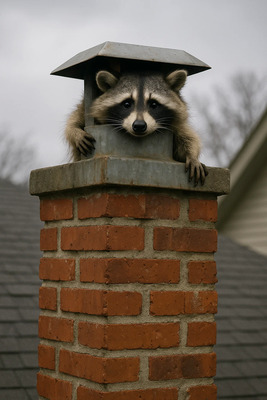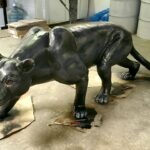Chimneys often attract wildlife seeking warmth and shelter, especially during colder months. When scratching, chirping, or flapping sounds echo from your fireplace, it usually means there’s an animal stuck in chimney. Recognizing which type of creature is trapped is essential for safe and humane removal, as each species—whether it’s a bird, squirrel, raccoon, or bat—requires a different approach. Proper identification and response help prevent damage, disease spread, and potential fire hazards.
Why Does Identifying the Type of Animal in Your Chimney Matter?
Correctly identifying the type of animal in your chimney matters because each species behaves differently. Birds may nest near the chimney cap, squirrels can gnaw through flues, and raccoons might enter to give birth. Knowing what’s trapped ensures safe removal, prevents injury to both the animal and the homeowner, and avoids costly structural damage. Furthermore, it reduces the risk of dead animals decaying in the chimney, which can cause foul smells and attract insects. Misidentifying the problem could result in using the wrong traps or removal techniques, worsening the situation.
What Are the Common Signs and Problems of Having an Animal Stuck in a Chimney?
The first indicator of a trapped animal is sound. You might hear scratching, flapping, or squeaking from within the walls or chimney. For example, birds and bats produce light fluttering noises, while raccoons and squirrels create louder, more deliberate scratching or thumping. If the sounds occur mainly during the day, it could be squirrels or birds. Noises at night often point to raccoons, mice, or bats.
Another telltale sign is the smell of decay, which means a trapped animal may have died. Additionally, nesting materials, feathers, or droppings near the fireplace indicate that animals have made their way into the flue. Foul odors can linger throughout the house, especially when the fireplace is used, as heat amplifies the smell of trapped or dead animals. Chimney blockage from nests or debris can also increase the risk of smoke backup and carbon monoxide exposure inside the home.
What Are the Key Benefits of Professional Animal Removal Services?
Professional animal removal services ensure the safe, humane, and efficient extraction of wildlife without harming the structure of your chimney. Certified technicians can identify the animal type—whether raccoons, squirrels, or birds—and use species-appropriate traps. They also seal entry points to prevent future intrusions. One of the main benefits is avoiding personal injury. Many trapped animals, especially raccoons or bats, carry diseases like rabies and histoplasmosis. Handling them without proper gear is risky. Professionals also inspect for damage caused by gnawing, nesting, or droppings, ensuring your chimney remains safe for fireplace use.
Another advantage is odor elimination. Dead or decaying animals emit strong, unpleasant smells that spread through the house. Experts not only remove the carcass but also sanitize and deodorize the affected area.
How Much Does Animal Removal from a Chimney Cost?
The cost of removing an animal from a chimney depends on several factors, including the type of animal, accessibility, and whether the creature is alive or dead. Emergency calls and removal of large animals like raccoons typically cost more due to added safety precautions and specialized equipment.
Below is a general pricing breakdown:
| Service Type | Average Cost (USD) |
| Bird removal | $150 – $350 |
| Squirrel removal | $200 – $400 |
| Raccoon removal | $250 – $600 |
| Bat removal | $250 – $500 |
| Dead animal removal | $150 – $300 |
| Chimney cap installation | $100 – $250 |
| Inspection & sanitization | $100 – $200 |
Disclaimer: Prices vary depending on your location, the severity of infestation, and the company’s service scope. Always request a written estimate before scheduling removal.
What Features Distinguish Professional Chimney Animal Removal Services?
Expert wildlife control Chimney cap installation companies use advanced diagnostic tools such as cameras and flexible scopes to locate trapped animals deep inside the flue. They identify species by observing droppings, nesting materials, and sound patterns. For example, raccoons tend to make low growling or chattering noises, while birds produce repetitive chirping. Another distinguishing feature is the use of humane traps and exclusion methods. Rather than killing, professionals rely on one-way doors or cage traps to safely capture and release animals. They also install chimney caps or screens to prevent future entry.
Licensed removal services ensure compliance with state wildlife regulations, as certain birds and bats are protected by law. The inclusion of post-removal cleanup and odor treatment is another key feature. Proper cleaning prevents pest attraction, mold growth, and respiratory issues. Reputable providers also offer warranties on their exclusion work, ensuring peace of mind.
How to Identify Specific Animals Stuck in Your Chimney?
- Birds: Light flapping, chirping, or wings brushing against metal walls. Birds often get trapped accidentally and may die if not removed quickly. Installing a chimney cap helps prevent nesting.
- Squirrels: Continuous scratching and scurrying sounds. They can climb up and down walls and may enter from nearby trees. Their nests can block the flue and cause smoke backup.
- Raccoons: Loud thumping or growling noises, often at night. Female raccoons sometimes nest in chimneys during spring. They are strong and can damage dampers or bricks trying to escape.
- Bats: High-pitched squeaking at night, usually from a group rather than a single animal. Bats carry diseases and should only be removed by professionals using exclusion devices.
- Mice or Rats: Light rustling or squeaking sounds. These small animals can crawl into narrow gaps and walls near the fireplace.
- Cats: Meowing or scratching noises indicate that a pet or stray cat may have fallen in. Never light the fireplace until the animal is safely removed.
“If you hear sounds in your chimney—don’t wait. Call a professional immediately to prevent injury, fire risk, or unpleasant odors in your home.”
FAQs
1. Can animals die if trapped in a chimney too long?
Yes. Animals stuck in chimneys can die within days due to exhaustion, dehydration, or starvation. A dead animal in the chimney will produce strong odors and attract insects.
2. How do I get rid of birds in my chimney?
Contact a certified chimney sweep or pest control expert. They can safely remove trapped birds and install caps to prevent future nesting.
3. Will raccoons come through the fireplace?
It’s rare but possible. Raccoons are strong and may attempt to push open dampers or grates if panicked. Keep the fireplace closed until removal is complete.
4. Can I use smoke to drive animals out?
No. Using smoke or fire is dangerous and can kill the animal or cause property damage. Always call a professional.
5. What if I smell something dead in my chimney?
That likely means an animal has died. Contact a wildlife removal service to extract the carcass, sanitize the area, and inspect for damage.
6. How can I prevent animals from getting stuck again?
Install a stainless steel chimney cap with a mesh screen, trim nearby tree branches, and schedule annual chimney inspections.
Conclusion
Identifying and safely removing an animal stuck in your chimney requires a careful, informed approach. Each species—from birds and squirrels to raccoons and bats—presents unique challenges and health risks. Attempting to handle the problem yourself can lead to injuries, property damage, or legal issues if protected species are involved. Professional wildlife removal ensures safe extraction, thorough cleaning, and preventive measures to keep your home pest-free. Regular chimney maintenance, paired with a proper cap or screen, is the best long-term solution to avoid trapped animals, unpleasant odors, and fire hazards. For any unusual smells, sounds, or movements from your chimney, call a certified chimney sweep or animal removal expert near you immediately.
Read More: Chimney Sweep Louisville



